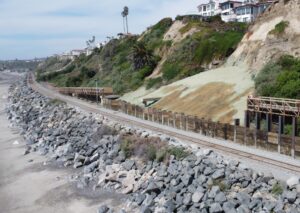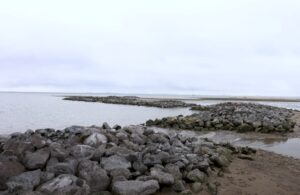Court Upholds Coastal Commission’s Stance
In a split decision, the Fourth District Court of Appeal has upheld the Coastal Commission’s conditions on two property owners’ reconstruction of a seawall in Encinitas after it was destroyed in a storm, including limiting the new seawall’s permit to a 20-year term.
The majority ruling by Presiding Justice Judith McConnell is written much like a dissent, whereas the dissent by Justice Gilbert Nares reads like a majority opinion. This suggests that the third justice, Cynthia Aaron, may have switched her position during the writing of the opinion.
In any event, the ruling is a strong affirmation of the Coastal Commission’s muscular approach to permit conditions, as the majority concluded that the reconstruction of the seawall is subject to a coastal development permit even though it was destroyed in a storm. In the majority opinion, Presiding Justice McConnell explicitly rejected the property owners’ argument that they had agreed to conditions on the permit approval under duress and therefore were entitled to relief from those conditions.
The case involved a deteriorating sea wall that protected the properties of Barbara Lynch and Thomas Frick from the ocean in Encinitas. In 2009, Encinitas had approved replacement of the seawall, including reconstruction of a stairway to the beach. However, in 2010 – while this approval was pending in front of the Coastal Commission – portions of the seawall, including the stairway, were destroyed in a storm.
In 2011, the Coastal Commission approved a permit to replace the seawall but the permit included conditions specifically precluding reconstruction of the stairway and also limited the duration of the permit to 20 years. The permit also required that the property owners accept a deed covenant including the conditions.
Lynch and Frick sued, and San Diego Superior Court Judge Earl Maas ruled in their favor. On appeal, however, the two-justice majority reversed Maas and ruled in favor of the Coastal Commission.
The majority noted that the the property owners – represented by local attorneys with the assistance of the Pacific Legal Foundation – argued “there is or should be an ‘under protest’ exemption for permit applicants who are opposed to nonfee conditions like those at issue in this case and desire to build their projects while simultaneously challenging the conditions.”
The majority rejected this idea, saying such an exemption would make it impossible for the Coastal Commission – or any other land use regulatory agency – to adequately address a project’s impacts. “If an agency learns a nonfee condition is invalid before a project is built, the agency may be able to address the impacts underlying the condition in an alternate manner,” McConnell wrote. “However, if an agency learns a nonfee condition is invalid after a project is built, the agency may have no practical means of addressing the underlying impacts.”
Importantly, McConnell’s opinion upheld the validity of the 20-year permit limitation in part based on the Coastal Commission’s emerging – but still vague – guidance on sea-level rise. She noted, among other things, that “shoreline protection strategies are evolving, particularly in light of climate change and sea level rise,” and concluded that the Commission had to right to revisit the permit during a time period more or less consistent with the lifespan of the homes in question.
The property owners had argued that Public Resources Code Section 30235 gave them the right to rebuild the seawall under any circumstances, but the majority concluded that this right is “permissive, not exclusive … The statute does not purport to preempt other sections of the Act that require the Commission to consider other factors in granding coastal development permits.”
The majority also upheld the Coastal Commission’s right to remove the stairway from the project plans, saying that the Coastal Act “allows the replacement of an existing structure without a permit only if the structure was destroyed by a disaster, conforms to applicable zoning regulations, is for the same use, is no more than 10 percent larger than its previous size, and is in the same locations.” Subsequent to the storm, the court noted, the nature of the stairway replacement changed significantly.
In his dissent, Justice Nares concluded that the time-limit on the permit is unconstitutional, an argument likely picked up from the Pacific Legal Foundation, which often makes constitutional arguments in land-use cases. He said the 20-year expiration clause “unconstitutionally forces the homeowners to waive their rights and property interests without any nexus or ‘rough proportionality’ to potential adverse impacts caused by the seawall” – a reference to the Nollan/Dolan line of U.S. Supreme Court cases which requires nexus and rough proportionality to uphold the validity of exactions.
In this case, Nares said, the Coastal Commission makes so nexus claim regarding the 20-year limit but simply reserves the right to re-examine the permit at a later time – and most likely reject continuation of the permit. “The Commission has made clear its opposition to seawalls in general, and the homeowners’ seawall in particular. When the homeowners’ seawall permit expires, the Commission will have a negative easement over the homeowner’s bluff, without paying for it as required by the takings clause.”









